Costumes & Characters
"I wanted to bring fairy tale and magical creatures to life for the
audience."
— Michel Crête, Costume Designer
While you're wandering around the great tent, you might run into a group
of fairies, a court jester or a couple of seedy-looking cabaret characters.
The person to blame is probably Michel Crête! Crête, 33, is a graduate of the
National Theater School of Canada, who has designed the scenery for several very
successful plays over the past 3 years, including "Being at Home with Claude" by
Rene Daniel Dubois, "Fool for Love" with Marie Tifo and Guy Tauvette, "Carmen" by
Robert Lepage, "Brighton Beach Memoirs" performed by Jean Duceppe's Company at
the N.C.T.

|
Why did he join the circus? He likes the spirit of friendship, he enjoys a
challenge and he finds the work stimulating! "In the theater," says Crête,
"costumes are designed with the characters in mind, but in the circus, their
design depends on the type of performance, I wanted a compromise between the two,
and the athletic side of the circus made me more conscious of the body and the way
it is made." Michel Crête has captured the athlete's energy by creating strange and
fascinating characters that explode into a myriad of colors!
Some of the costumes are part of a move to make a clean break from the military
and equestrian basis of traditional circus costume, contributing to the emergency
of a fresh take on circus characters. The playfulness of these costumes - polar
opposites of severity and rigidity of the conventional aesthetic - expresses the
freedom and spontaneity of the young artists and their spectacular feats.
The use of bright primary colors for the acrobat's costumes was intended not only
to contrast with the grays and browns worn by people in the street, but also to
render the idea of freshness and purity while making a big splash.
|
The costumes of the King of Fools and the Clown Children, in particular, were
designed based on expressionist drawings that give off a glowing energy - one
might call them radiant Rorschach inkblots. Underneath the jumble of colors
applied in broad strokes, the silhouettes of the small characters can just be
made out. Cut and assembled asymmetrically, magnificent cotton fabric bearing huge
prints would make it possible to bring the characters drawn on paper to life.



Ti-Claude (Ringmaster)
"Welcome Ladies and Gentlemen". This is the first official contact between the audience and
the chef de piste. There's something about the way he taps his foot and wags
his head. Since he is the symbol of authority, the Ring Master delights in telling the clowns
what they can and can't do, and he even chides the audience for siding with the unruly rogues.
There isn't much of the traditional ring master about him. Why, he's just about to leave the
ring to appear as Ti-Claude, who will eventually guide those you have yet to meet toward a
magical metamorphosis.
Michael Barrette, one of the veteran performers at Cirque du Soleil, played
the role for the 1987 and 1988 tours. James Keylon, who'd become half of the
Alfredo et Adrénaline comedic duo, took over the role for the 1989 and 1990
tours, presenting the ringmaster as Alfredo di Carbonaro.
King of Fools / Queen of the Night
Out of the billowing white cloud emerges the King of Fools (played by Marc
Proulx in 1987 only) or the Queen of the Night (played by Angela Laurier in 1988,
Sally Dewhurst in 1989) and his/her helpers. They invite the imagination of the
audience as they "transform" everyday Oridinary People (portrayed by cast
members) into magical Cirque performers. Music, movement, colour and light
combine to produce an atmosphere of true enchangment. In the acts that follow,
each of the performers will play out his or her destiny. The King of Fools /
Queen of the Night creates a link between the acts, inventing a story line which
runs through the show.
The Ordinary People
Now, the ring is full of ordinary people dressed in their everyday clothes, milling
about and exchanging looks of amazement with the audience. Is this a dream or is it
really true? Who knows? The truth is that they begin responding to some mysterious urge
to let out some of the folly and playfullness buried deep down in each of them, and in
each of us. Arabesques, cartwheels, handstands... they can hardly contain their joy! Dream
or reality? All we can tell is that they're being drawn into a world of fantasy and so
transformed they they become an integral part of the show.
Denis Lacombe (1987, 1988 & 1990)
Bronze medalist at the World "Circus of Tomorrow" Festival in Paris in
1985, Denis Lacombe toured with the Cirque du Soleil in 1985 and 1986 and
performed with the Big Apple Circus of New York during its 1986-1987 season.
The Cirque du Soleil is pleased to have Denis present a number of his hysterical
creations for the show.
As "The Mad Conductor," (Chef d'Orchestra) an all too-serious conductor gets
carried overboard battling cascading score paper, lost batons, and an unsteady
podium to execute a certainly 'unique' rendition of Tchaikovsky's 1812 Overture.
When Denis is ambushed by an "Invisible Man", the result is one of the funniest
tragi-comic episodes you could possibly imagine (he's beaten up by an unseen
assailant). When he plays a "Mechanical Clown" caught up in a zany adventure,
Lacombe works the audience as a crazed wind-up toy clown run amok... with
whipped-cream pies. (Note: Denis would join Le Cirque Réinventé on
September 3, 1987 in California and perform through to the end of the 1987 tour.
He then performed throughout the 1988 tour, did not perform in the 1989 tour,
and returned for the brief 1990 tour.)
Benny Le Grand (All)
After five years of putting the glue on fly-catchers, Benny Le Grand enters
the select world of the peforming arts. He leaves Saskatoon and is hired on as a
spare tire by a traveling circus. He later writes, produces and performs the worst
magic acts ever seen in North American. Benny is the perfect example of the
independant artist all funding agencies flee like the plague. The Cirque du Soleil
thinks Benny le Grand is just "Great"! Benny loves wandering through the crowd
before the show begins, playing obnoxious tricks on unsuspecting patrons, such
as hectoring ticket holders as they search for their seats, snatching women's
pocketbooks and examining the contents, mischievously spray purfume from a
stolen purse on others in the crowd, or drench anyone asking for a drink from
his bottle of "free Canadian Spring Water". But beware... he has a not-so-
successful escape trick up his sleeve.
Catitan Cactus (1987)
Former tree-planter, carpenter, bricklayer and label-sticker, Catitan Cactus
never was one to lay about doing nothing. After he happened upon his career as a
clown in Downtown Mexico City while celebrating a friend's birthday in 1968, Catitan
searched high and low for a circus ring to perform in. He came to Canada in 1976,
and to Cirque du Soleil in 1987. We're told he's got a mean Karate chop, so watch
out!
Tonatiuh Morales (1988)
The gag may be subtle or slapstick and the intention boyish or biting, but he
always seems to know what buttons to push to trigger a roar of laughter. Tonatiuh tries to go
unnoticed, except durring the takeoff he does early in the show. To no avail. You'll find
him popping up all over the place, and doing what you least expect! The 1987 Circuba
festival held in Havana found Tonatiuh just as crazy as Cirque does, and gave him first prize
in clowning to prove it!
Madame Zazou (1988)
Portrayed by Dolorèze Léonard, Madame Zazou is said to have "a voice that
Louis Armstrong would have envied", a sort of "Mae West with a zesty Quebecois
accent". Performed in at least San Francisco and New York City, Madame Zazou
tickled in her ridiculous night security guard routine.
Balthazar (1989 & 1990)
Balthazar (whom Cirque fans may recognize later on from La Nouba) performs
"Window with String". He goes through a series of wonderfully witty visual
effects, changing from window to stringed instrument, then becoming a
spider's web, engulfing his face complete with a buzzing fly. He may also
choose you for his "Lion Tamer" routine in which a spectator is outfitted
with a lion's mane (a dust mop with the center cut out), and put through
your paces. Each time you obey (sitting on a tiny stool, opening your
mouth to let him put his head in) he'll adopt a bravura pose to for the
audience's laughter and applause, and then reward you with a lollipop. Hang
on to those. For when he brings out a flaming metal hoop and encourages you to
jump through it, you just might want to hand those lollipops back!
Alfredo et Adrénaline (1990)
They are James Keylon, an American clown / writer / director living in Quebec
who has years of experience in mime, clown and theatre, and Francine Côté,
a clown / teacher / director from Montreal who has years of experience in the
creation and performance of comic, physical and clown characters. Together they
make up the duo "Alfredo et Adrénaline" and neither are strangers to Cirque du
Soleil's stage. In 1983 after performing at the Fête Forain in Baie St. Paul,
Québec, Keylon was chosen to be the first clown company in Le Cirque du Soleil.
In 1985, Francine toured with Cirque in the clown troupe "La Ratatouille". In
1990, both returned to the Cirque for London and Paris' engagement of Le Cirque
Réinventé. Pushing in the direction of the modern clown, but inspired by the
traditional clown, these two lovable characters in the throes of their own
"Battle of the Sexes" have touched tens of thousands of spectators around the
world.
|
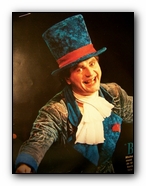
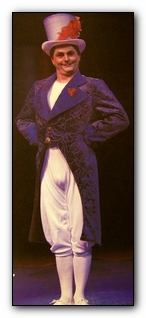
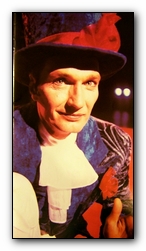
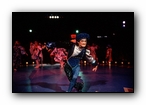
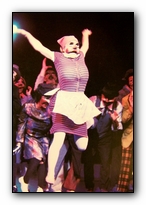

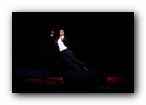
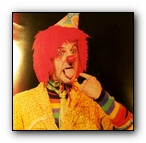
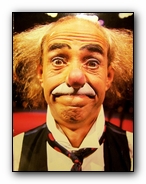
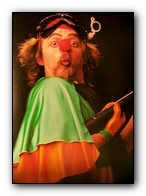
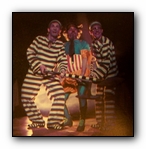
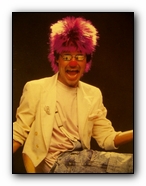
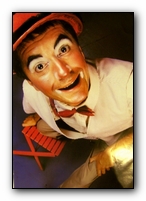
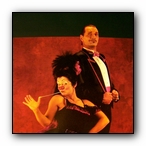
|
|

![]()




